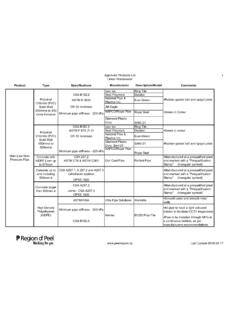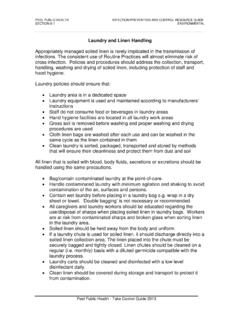Transcription of LITERATURE REVIEW ON EFFECTIVENESS OF THE USE OF …
1 LITERATURE REVIEW ON. EFFECTIVENESS OF THE USE OF social MEDIA. A REPORT FOR PEEL PUBLIC HEALTH. REBECCA SCHEIN, PHD(1), KUMANAN WILSON MSC, MD, FRCS (2) AND JENNIFER KEELAN, PHD (3). (1) ASSISTANT PROFESSOR, CARLETON UNIVERSITY, OTTAWA, ONTARIO, CANADA. (2) CRC (PUBLIC HEALTH POLICY), UNIVERSITY OF OTTAWA, OTTAWA, ONTARIO CANADA. (3) ONT MOHLTC CAREER SCIENTIST, ASSISTANT PROFESSOR, CENTRE FOR INNOVATION IN. COMPLEX CARE & SCHOOL OF PUBLIC HEALTH, UNIVERSITY OF TORONTO, TORONTO, ONTARIO, CANADA. TABLE OF CONTENTS. EXECUTIVE SUMMARY ..3. BACKGROUNDER ON social MEDIA USE ..4. RESEARCH METHODS ..6. POTENTIAL APPLICATIONS, CURRENT USES, AND UTILITY OF social MEDIA FOR HEALTH COMMUNICATION ..9. INFODEMIOLOGY AND INFOVEILLANCE ..14. CIRCUMVENTION OF ADVERTISING REGULATIONS THROUGH social MEDIA ..18. CHALLENGES / SUMMARY ..23. REFERENCES ..27. 1. STATS CAN DATA ON CANADIAN INTERNET USE ..32. 2. social MEDIA PLATFORMS ..35. 3. ANALYSIS OF INCLUDED 4. CASE 5. COMPETING WITH VACCINE-CRITICAL MESSAGING.
2 61. 6. INFOVEILLANCE / INFODEMIOLOGY: WHO IS SICK ..63. 2. Executive Summary Preliminary data from the field suggests that social media is becoming a powerful addition to the health communicators' toolkit. Although there is a great deal of interest in using social media as a tool for public health communications, the research evaluating its utility is still in its infancy. As of yet, few research studies have examined the broader utility of social media for the adoption of health promoting and protective behaviours. One of the chief conclusions of this report is that there is a paucity of peer-reviewed studies testing the utility of social media interventions for desired outcomes. Instead, research has focused on documenting the range of health-related behaviours and the content of health-related discourse on these platforms. Observational studies show an abundance of both informal health conversations related to public health issues and organized health-related activities on leading social media platforms such as YouTube, Twitter, and Facebook.
3 The quality of health information available to users on these platforms is highly variable raising some concerns that social media users are exposed to unopposed viewpoints that counter core public health recommendations and contemporary medical science, such as those opposing immunization and promoting smoking. social media is currently utilized by public health organizations both as a broadcasting platform to amplify messages from traditional media sources ( , radio, television, print media) and as an entirely new way of collaborating and co-creating content with target audiences. In the latter approach, organizations have had to adapt their communications strategies to incorporate user- generated content and feedback. The process of engaging users to co-create content, to rate, rank and comment on communications, more so than the resulting message, is increasingly perceived to give a heightened authenticity to messages, improving trust in, and building users'.
4 Relationships with, organizations. social media, unlike traditional media campaigns, provides novel opportunities to embed and interject public health messaging into the daily online conversations of Canadians. In the future, it will also allow public health communicators to deliver a range of health promotion messages and self-monitoring tools through mobile applications, an innovation that will potentially increase the reach to those without computers, and will allow public health messaging to penetrate the day-to-day health conversations and activities of Canadians. The adoption of social media by leading public health organizations reflects a widespread sense that these tools are increasingly necessary to reach demographics who are abandoning traditional broadcast technologies ( , telephones, television) such as teens, or a significant portion of the public who are rapidly transforming the manner in which they interact with experts. 3. Backgrounder on social Media Use In the era of the 24-hour news cycle, the traditional once-a-day press conference featuring talking heads with a bunch of fancy titles has to be revamped and supplemented with Twitter posts, YouTube videos and the like.
5 The public needs to be engaged in conversations and debate about issues of public health, they don't need to be lectured to. -Andre Picard, The Globe and Mail, June 9, 2010. Statistics Canada data indicate not only that more and more Canadians are using the internet at home in their daily lives (see Appendix 1 for a REVIEW of internet and social media usage trends), but that they are engaging in an ever more diverse array of online activities (1,2,3,4,5). These activities reflect the growing integration of online tools into Canadians' personal and professional lives and the shift from static Web platforms to the dynamic, interactive, and collaborative qualities of Web In addition to evidence of the accelerating popularity of online platforms like Facebook, Twitter, and YouTube, new data also suggests that organizations can increase feelings of trust and loyalty through social media use (5). Such trends are already generating widespread interest in the use of Web and social media platforms in research, policy and practice.
6 The precise boundaries defining these terms, however, are still emerging within the LITERATURE . As the number, diversity, and inter-operability of new web-based and mobile platforms continue to proliferate, the characteristics and subcategories denoted by the term social media will need to be further disaggregated and refined. There is general agreement, however, As of August, 2007, there were roughly 1200. that the new media environment is Facebook communities advocating for cures for characterized by interactivity, user- different diseases. The Canadian Cancer Society's generated content, and multi- Facebook community includes, as of the time of directional communication flows. this writing, 14,730 members from around the Broadly, the transition to Web world (6, ). marks a shift from a one-way conversation to a multi-way conversation, in which users participate as both creators and consumers of web content (7,8). The nature of the content produced by users varies considerably across platforms, from passively collected data that can be fed back into the system and reflected back to users in word clouds or other popularity metrics, to content actively created, propagated, and iteratively revised by users in wikis, blogs, and video-sharing or social networking sites, on RSS feeds, or through the creation and circulation of widgets, gadgets, and badges that can be embedded in sites across the web (9, ).
7 As Turnbull notes, the user behaviours 4. enabled by Web architecture have shifted the boundaries between experts/information- providers and laypeople/information-consumers: information is increasingly created and co- created by users in a dynamic, collective manner (8, ). Eysenbach began using the neologism apomediation (apo: separateness, detachment) to describe the way new online platforms allow users to bypass formal intermediaries, expert gatekeepers, or other middlemen: users do not act entirely without guidance, but rely instead on peers, web tools, and the aggregate knowledge generated by new collaborative platforms (10). The term social media is used somewhat loosely to describe an array of new Web platforms. Although they are not always clearly distinguished in the LITERATURE , the interactivity associated with social media should be differentiated from more generalized forms of online user engagement. For instance, many websites invite users to input their own information, customize the layout and look of a page, prioritize certain kinds of content, or keep track of their own online activities over time.
8 social media, by contrast, is characterized by interactivity across multiple horizontal connections, which produce in aggregate a mutable, collectively generated user experience (11, see also Appendix 2 for a description of the most popular social media platforms). Even within a single platform, users make use, to varying degrees, of the opportunities afforded for collaboration and social networking. YouTube, for instance, can be used simply as a broadcast medium for propagating a movie trailer or public service ad. It is only when other users begin to link to, remix, repurpose, and discuss posted content that YouTube's character as a social media platform comes fully into view. social media platforms are being studied by health researchers and mobilized for a variety of purposes: recruitment for clinical trials; professional development and training for clinicians;. inter-professional communication and coordination; training simulations; health social networks and health and illness support groups; health advocacy and fundraising for health organizations.
9 Development of interactive, self-management tools and plugins to popular social media platforms; public health messaging; infectious disease monitoring. This report targets original research, case studies, reviews, and commentaries related to public health communication, although there are at times significant overlaps between this subfield and those listed above. In addition, we summarize information from online sources related to notable public health campaigns (extracted from podcasts, interviews, PowerPoint presentations, and key public health organizations' websites). 5. Research Methods We conducted a systematic LITERATURE search of multiple databases, chosen for their coverage of a range of relevant disciplines, including medicine, public health, psychology, business /. marketing, and related social sciences using the keywords social media (health databases) or social media AND health ( social sciences/business/periodical databases). Between July 14. and July 16, 2010, we (JK and RS) executed keyword searches (See Figure 1 for the list of databases searched and the keywords utilized and the process of article selection and exclusion).
10 Search results (n=551) were imported into the reference software Endnote and combined into a master database for analysis. The final set of articles (n=39) was analyzed using the following categories: article type, research methodology, and major themes. The reviewer wrote a brief description of each article and, where appropriate, identified any new references (snowball) cited that may be relevant to this report (see Appendix 3). Snowball references were then compiled and vetted using the same procedure as articles found through the database searches. Reviewed papers were also ranked for relevance from low to high as they related to the core objectives of this report. Figure 1: Search strategy and inclusion criteria. Exact duplicates were identified and eliminated as well as articles written in languages other than English. Article abstracts were reviewed for their social media and health/public health communication content by both JK and RS. A subset of articles was reviewed in parallel by both (JK and RS) and the results showed 100% agreement in the application exclusion and inclusion criteria.











